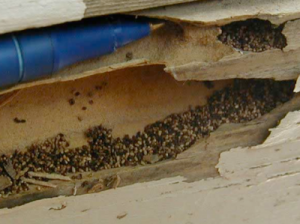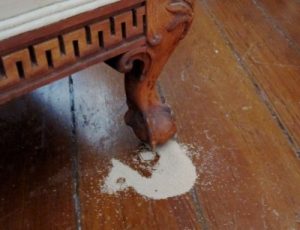
Knowing how the drywood termite swarmers (aka alates) look like and how they behave is especially important, because they can serve as messengers of problems that haven’t yet come.
The point is that they are the very kind of termites which you can easily notice when it’s yet not too late for measures to take.
An item, fallen into pieces, with squirming larvas in it, cannot be saved already; and it isn’t so important to know if it has been eaten by dampwood or drywood termites after all, whereas the fact that it’s been eaten by termites appears pretty obvious.
Hide content
- Flying termites
- Appearance
- Photo
- Reproduction
- What to do if the cloud is on the horizon?
Foams and insecticides Eliminate wooden mulch Apply bait Hot and cold temperatures Remove stumps and other attractors Release nematodes- Useful articles
- Helpful video
- Conclusion
There are common questions: do drywood termites swarm? When do drywood termites swarm? Learn more about this type of termites in our article.
Flying termites
The bad news is that termite swarmers can fly, and only their swarmers can fly. In fact, termites live in a “society”, divided into a few different castes, playing different roles in a colony. Those are the castes:
- Workers (in drywood termites society it isn’t really a “caste”, but a group, in which immature soldiers and swarmers come);
- Soldiers;
- Swarmers (aka alates).
Even though members of the last caste have wings, they quickly shed them after mating. So a good method of defining whether the termites are drywood or subterranean ones is to look if there’re winged species among the dead.
Appearance
A termite swarmer has a tan or brown body and two sets of wings, which color can vary from pure white to smoke grey.
The front set of wings has a pattern of three or more heavy, well-pigmented veins in the outer part of that front wing.Total length of a drywood termite alate is about 7/16 inches, including the wings. As you can probably see from this description, termite alates look very similar to flying ants and needless to say that termites of different kinds also look almost alike, which is why it is necessary to know for sure how to differentiate those three.
Drywood termite swarmer Flying ant Subterranean termite swarmer Dampwood termite swarmer Waist width The waist is as wide as the rest of the body Thin waist (a narrow area between the thorax and first abdominal segment) The waist is as wide as the rest of the body The waist is as wide as the rest of the body Wings size All drywood termite wings are more or less of the same size Two frontal wings are bigger than the back ones All wings are more or less of the same size All wings are more or less of the same size Veins number Wings have three or four veins Wings have few veins Wings have two veins Wings have two veins Veins color Veins color is milky Veins color is clear Veins color is milky Veins color is milky Body length 1/3 inches long body 1/3 inches long body 1/3 inches long body ½ inches long body Wing shed Shed wings quickly Always carry their wings Don’t shed wings immediately after landing Shed wings quickly Antenna Shape Antenna is straight Antenna is elbowed Antenna is straight Antenna is straight Photo
Pictures of drywood termite swarmers you can see below:
Reproduction
The swarmers fly out from the colony in summer and autumn to colonize new “lands”. The exact limits of swarming season depend on what subspecies a termite belong.
Drywood termites swarming season. While Western Drywood Termite swarms during the day between September and November, The Desert Drywood Termite swarms in the evening from July to September at night.
As it was mentioned above, swarmers do have wings, so they can travel to found new colonies, though they are poor fliers, and for this reason they can hardly travel at long distances.
When a suitable nesting place is found, they drop to the ground, shed their wings, burrow deep into wood, he-termites (kings) mate with she-termites (queens) and after that the queens start laying eggs, which develop into larvae and then into adult species of all three castes.
Kings’ lives are quite short, but queens can live up to astonishing 25 years and spawn new species throughout their entire lives. In the first year, colony size may be only around 50.
After four years, a new found colony can grows to 700 individual drywood termites. At this time, the colony may swarm to start the cycle over again. After fifteen years, the colony grows to approximately 3000 species.
What to do if the cloud is on the horizon?
Here you can read about 7 ways of what to do if you noticed a swarm of alates in your house:
Foams and insecticides
This measure of fighting against termites’ infestation is the most widely-spread of all. There’re many forms in which insecticides come, from gasses to liquids.
But whatever the form you choose, you’ll have to leave your house for a while, since these chemicals are hazardous to inhale. Poisonous foams are also very efficient at killing termites and other bugs, because of its ability to fill in cracks and holes in the wood.
Eliminate wooden mulch
Wooden mulch attracts termites as practically nothing else does.
If you’re looking for a termite attractor, mulch is the first thing you should pay attention to.
Either get rid of this substance or, if you really need it, try to move away from your house as far as possible.
Here you can learn more information about effective treatment method called tenting (fumigation): dangers for termites, preparing for fumigation and cleaning after, how long does this procedure last?
Apply bait
Using bait station and boric acid is yet another way to get rid of this vermin. This is how you can cause damage to the existing colonies: set the bait station and then spray wood with the boric acid, which is a deadly toxic for them.
As soon as they notice the bait and arrive at it, the acid will mercilessly kill them. In order for this measure to take effect, don’t forget to spray the acid on a regular basis so that the whole population of the insects died out.
As an example of a ready-to-use solution, you can have a look at the Advance Termite Bait System, which has proven to be very effective.Hot and cold temperatures
As termites cannot survive if the environmental temperature is below 27 °C, by that same token they die when it’s hotter than 48°C for more than 35 minutes running.
So you can either freeze the termites with liquid nitrogen or simply burn them. Of course, these methods are only applicable for outdoor termites.
Remove stumps and other attractors
Removing potential food for termites isn’t entirely a way to eliminate already existing infestation; it’s rather a way to prevent it. Stumps, old wooden buildings’ carcasses, planks, fallen trees – everything that consists of rotten wood should be taken away from the place you’d like to protect. Less food for termites means fewer termites.
Release nematodes
Nematodes are bad neighbors. They toss cigarette stubs out of the windows, litter on driveways and loudly quarrel at night.
Highly cultured termites can’t stand such hooligans and move away.
But if to talk seriously, nematodes are natural parasites that affect garden pests. They look for hosts and burrow into them, in our case their targets will be termites’ larvae.
Deprived of many larvae, termites’ population will face steady decline.
In short, these are the things you should’ve come away with after reading this article: upcoming invasion by termites can be noticed by the presence of alates, winged swarmers in your house.
Learn more about drywood termites: signs of their activity; best methods of treatment: spot treatment and DIY methods; how to get rid of them in furniture?Those creatures usually swarm in summer and fall. Termites can be repelled and/or killed by using 7 techniques:
- Using of foams and insecticides;
- Wooden mulch destruction;
- Bait use;
- Applying hot and cold temperatures;
- Removal of stumps and other attractors;
- Nematodes release.
Useful articles
If you interested in more information of termites we recommend you to read the following articles:
- All types of termites. Are they harmful to humans? Can they bite you? And what is the difference between drywood and subterranean ones?
- What does swarmers of different species look like: subterranean, formosan?
- Signs of infestation outside and in the house: in walls or furniture.
- What does termite holes look like? What is droppings and is it toxic to humans? Do termites make noises?
- Posible termite damage, how does it look like? Examples of damage in walls and wood floors.
- All about flying termites: how do they look like, swarming season and what to do if there are swarmers in your house?
- How do they do nests and mounds? How to find it in your garden or inside the house?
Helpful video
For better drywood termite swarmer identification see video below:
Conclusion
However these methods should only be used if there’re termites, not winged ants in your house. So you should pay closer attention to outlook of the insect you came across.
Remember that, unlike flying ants, termite swarmers have all wings of the same size, wide waist and straight antenna.







